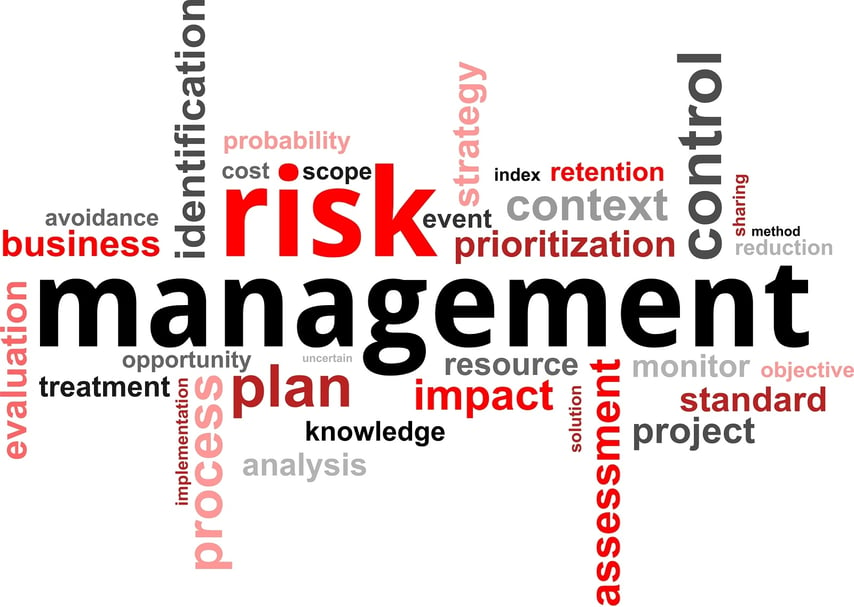
The selection of a quantitative or qualitative techniques depends on the availability of data for hazard identification, and on the level of analysis and evaluation you need to make a confident decision. Some techniques are more suitable than others for certain situations, activities or systems. The following are key factors for the selection of risk assessment techniques or methodologies (Mullai, 2006), with additional criteria that may be added to take into account industry-specific factors:
Risk tool selection based on business phases of the mining industry (Australia), 2016
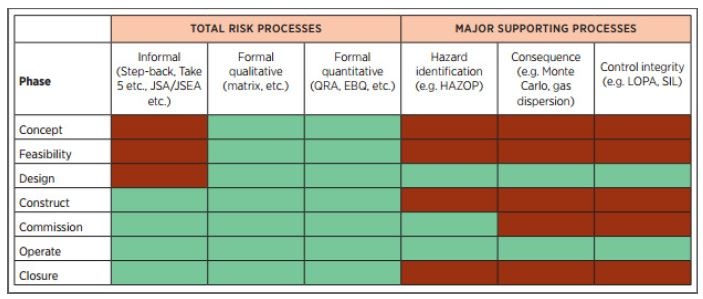
Risk tool selection based on risk consequence in the mining industry (Australia), 2016

Note: The green cells are preferred risk tools, while the red are non-preferred or unsuitable risk tools. SIL stands for safety integrity level; JSA/JSEA is job safety analysis; QRA is quantitative risk assessment; EBQ is experience-based quantification; LOPA is level of protection analysis, and HAZOP is hazard and operability.
Source: Australian Government, 2016
Application of risk assessment methods in the different stages of a project life cycle in the mining industry (Australia), 2007
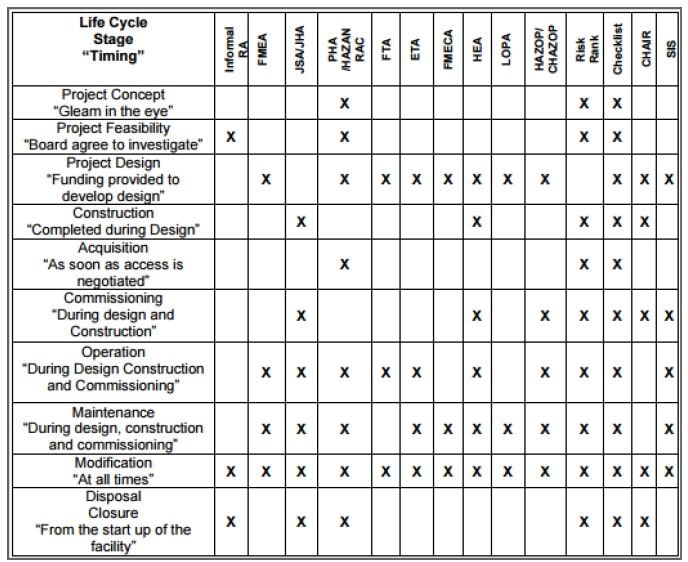
Note: RA stands for risk assessment; JSA/JHA stands for job safety or hazard analysis; PHA is preliminary hazard analysis; HAZAN is hazard analysis; RAC is risk assessment and control; HEA is human error analysis; LOPA is level of protection analysis; CHAIR is construction hazard assessment and implication review; SIS is safety-instrumented system.
Source: Joy & Griffith, 2007
As illustrated in the tables above, a wide range of risk assessment approaches is available in the mining industry, which are selected per business phase or risk consequence. More complex techniques generally deliver more accurate results, but they require increased cost of time, effort and need for greater specialist expertise to conduct risk analyses and evaluations. A combination of risk assessment techniques may prove most efficient and should be regularly reviewed for continual improvement (Australian Government, 2016).
The following aspects should be considered when choosing a risk analysis technique
(Australian Government, 2016):
- Qualitative techniques are simple to use and are very useful for sorting risks and establishing to what level, in an organisation, a risk needs to be elevated. Qualitative techniques are unlikely to withstand scrutiny, especially when the complexity of the scenario increases.
- Semi-quantitative techniques are also easy to use and can provide more insight than qualitative methods regarding the nature of the risk and associated control measures.
- They can provide more uniform risk analyses.
- Quantitative risk assessments, if carefully designed and implemented, can overcome many of the drawbacks of qualitative measures. Quantitative methods are useful for making complex decisions that involve business risk events and environmental and social issues. The evaluation outcome can be expressed in equivalent financial terms and incorporated into business plans.
- However, quantitative methods are less effective for evaluating environmental impact where there is a diverse range of environmental and social issues to be evaluated and their risk to be communicated to the community and other stakeholders. This is due to the fact that people tend not to accept the concept of placing a monetary value on intangible and emotive events.
- The successful application of quantitative risk assessment depends on the availability of necessary data, especially for simulation and modelling methods, the capacity and commitment of the organisation to manage the process, and available expertise.
- The mathematical modelling complexity of fault tree technique results from interrelationships between factors and controls. For example, some failures are more likely to occur if another control fails, because they may be caused by common factors including age, corrosion, design faults, and fire, among other factors.
Most successful and least effective risk assessment practices in the manufacturing industry,
2015
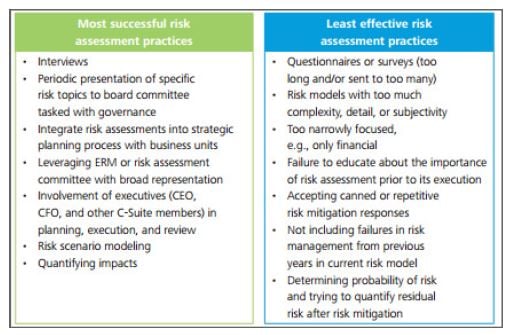
Source: Deloitte, 2015
Abrahamsen and Aven (2012) recommend reconsidering operators’ duty regarding risk assessment and controls in the Norwegian petroleum sector. They argue that risk acceptance criteria should be formulated by the authorities (the UK is a good example), rather than the industry itself, as operators’ activities often cause negative externalities to the society, such as environmental pollution, which influences other companies’ decisions. The expected utility theory in economics forms the basis of the discussion (Aven, 2016).
The following table demonstrates an example in the electrical utility industry, where a combination of risk analysis methods are used per category of risk consequence.
Summary of risk consequence categories, their predominant impact, and risk analysis methods used in the electrical utility industry, 2009
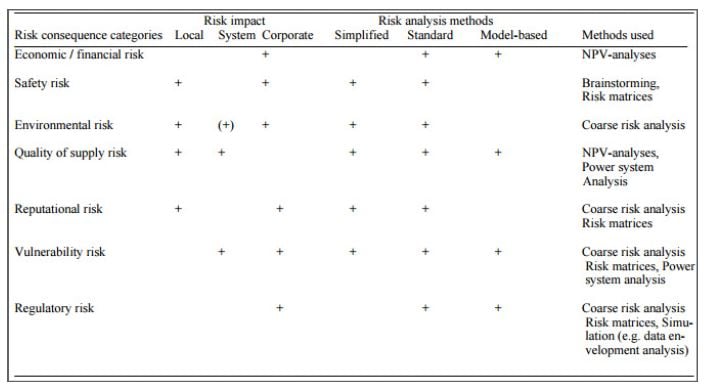
Note: Simplified methods refer to qualitative methods, standard methods are qualitative or quantitative, and model-based methods are quantitative.
Source: Nordgard, Sand & Wangensteen, 2009
In the construction industry, the application of risk management techniques depends on the nature of the project, the organisation’s policy, project management strategy, risk attitude of the project team members, and availability of resources (Banaitiene & Banaitis, 2012). A risk assessor model by Jannadi & Almishari (2003) determines risk scores for various construction activities. The model provides an acceptability level for the risks and determines a quantitative justification for the proposed remedy.
In New Zealand, an activity-based qualitative risk identification and assessment methods for anti-money laundering, assess risk by characterising the following aspects into low or high risk characters (The Department of Internal Affairs New Zealand, 2014):
- The nature, size and complexity of the business
- Types of customers dealt with
- Customer behaviour
- Methods by which financial products or services are delivered to customers
The generation of risk assessment information is often supplemented by decision analysis tools such as cost-benefit analysis, cost-effectiveness analysis, and multi-attribute analysis. For example, a cost-benefit analysis calculates expected net present values or expected costs per expected saved lives. However, these cost-benefit criteria do not adequately reflect the uncertainty component of risk (Aven & Abrahamsen, 2007; Aven, 2016).
For most financial institutions a reduction of expected loss in the order of 10% would be sufficient to justify the cost of conducting risk assessment. The development of risk framework, tools and management techniques that allow organisations to reduce losses will remain a key priority in the banking sector (Mirzai & Makarov, 2005).





